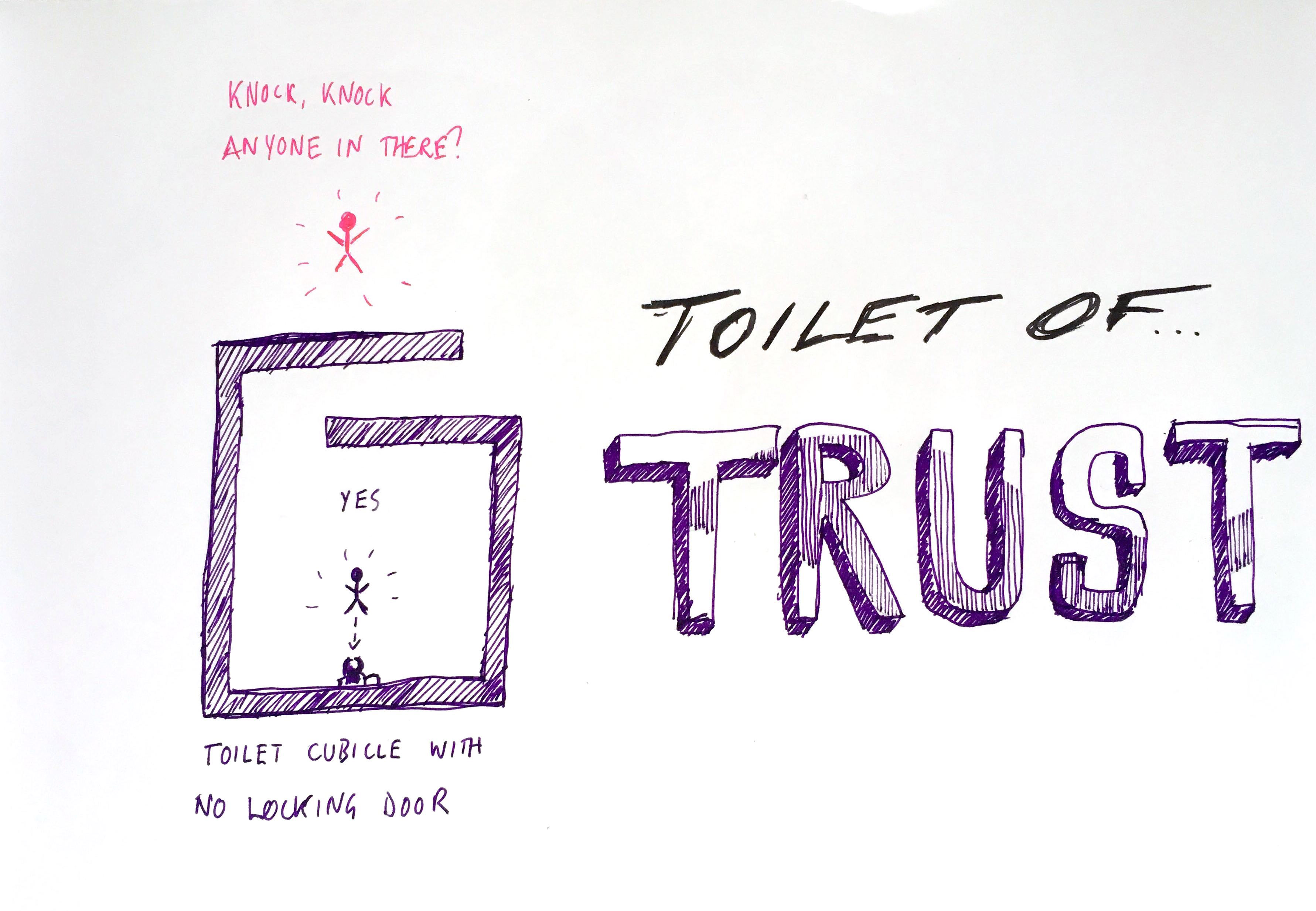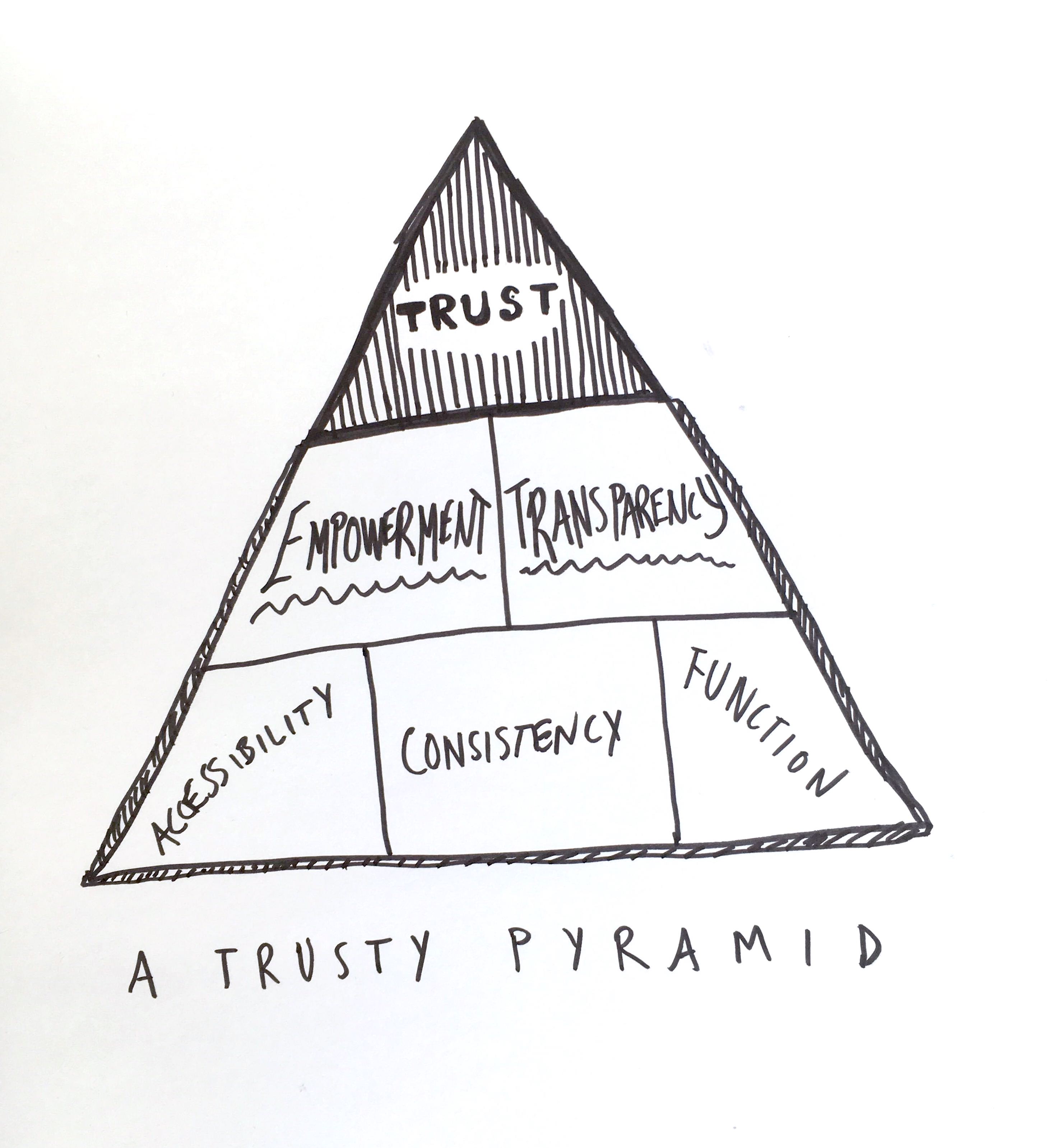Trust is something you have to earn from your users and from each other
Check out this diagram of revolutionary trust-based toilet cubicle. This toilet has no locking door, so if you want to use it you simply have to trust that the person waiting after you will knock before barging in. If everyone uses this trust model correctly, the toilet users will have the privacy that they deserve.

The only way that this would work would be if you made yourself known both inside and outside of the cubicle every time — you can’t see each other, so you have to make the effort to be transparent. Ah yes, transparency… a key player in the world of trust. This toilet is of course a very extreme model of trust (and I’m definitely having one installed in my house) but it gets us in the right head space.
Trusting a product
A couple of months back I wrote a piece outlining how humans have harnessed the power of technology, and subsequently abused that power. In it I talk about self-driving cars: the technology for fully automated vehicles already exists. But our trust in them does not.
So despite the fact that humans crash into each other all the time, we put less trust in vehicles that are literally designed to do the opposite. This is where trust overlaps with a fear of the unknown. If you don’t know whether something will work because you’ve never seen it before, it’s very hard to trust it. And that is exactly why trust needs to be earned.
Where trust overlaps with a fear of the unknown: the technology for fully automated vehicles already exists. But our trust in them does not.
What we’ve built at Company is a sort of unofficial trust framework for products. It’s made up of everything that you need to get to a trusty product. So working backwards, if you want your users to trust your product you need:
- Empowerment for the user. That is to say, it puts control in the user’s hands. Trusting a product is even easier if you have some kind of control over how it works for you.
- Transparency: with every action the user takes, it should be clear what the product is doing with the user’s data. E.g. a Consent Manager doesn’t just block cookies, it informs you of what they are and gives you control over them

So empowerment and transparency are two key things that lead to trust. But to get those you first need:
- Function: the product must work correctly — if the product doesn’t work, you can’t use it and therefore empowerment goes out the window.
- Accessibility: everyone must be able to use it, whoever they are. This brings us to empowerment again.
- Consistency: on Monday, you expect all features to behave the same way as they did on Friday. Either that or there has been something to announce a change — that announcement is you being transparent about your product.
These are the building blocks we used to put a Consent Manager together, and this is how we are building all future products. You cannot get a trusty product without all five things. It’s a great formula 👩🏫
Trusting the organisation
Our trusty products have filtered down from a trusty team. But how do you build a trusty team? By leading by example. Company started with Ben (CTO) and Rich (CEO) and they are the ones who lead and steer the team — we do not operate on a flat hierarchy, but we trust Rich and Ben to lead us in the right direction.
Nobody cares how many management courses you’ve taken: you’re not managing anyone if they don’t trust you. The first step in becoming a trusty leader is not to make yourself out as a strong-willed authoritarian. It’s to be vulnerable.
The first step in becoming a trusty leader is not to make yourself out as a strong-willed authoritarian. It's to be vulnerable.
I recently wrote a guest piece for Squarecat about companies who embrace transparency, and how it works for them. One company I wrote about was Baremetrics, simply because of Josh Pigford’s (the founder) content strategy. His open and confessional blog makes him look vulnerable. Being vulnerable is relatable. If you can relate to someone, you can seriously start to build a trusting relationship with them.
 Pigford opened up about himself and a follower identified with him because the post is relatable — this seriously helps with building trust.
Pigford opened up about himself and a follower identified with him because the post is relatable — this seriously helps with building trust.
A trusty leader does not have all the answers. If someone came to Rich with a problem or a question, and Rich did not know the answer, there are two ways he could handle this. Let’s say I ask Rich how we get more Twitter followers. He could respond with either of these:
OPTION ONE: “Every tweet we send should belittle our competitors — people will love that. Just do that. We will double our followers in like a week”
RESULT: We look petty and unprofessional on Twitter and we lose followers which is the opposite of what we want…
OPTION TWO: “I don’t know. We could figure this out together, maybe?”
RESULT: Rich and I take a collaborative approach to solving a problem and we both actually learn something.
I’ve seen it many times through my career: whoever’s in charge will run to option one, in the name of a ‘what I say, goes’ attitude. That is not how good leaders operate. Not knowing the answer is fine, because you are a human. Just guessing to look authoritative will get you nowhere. Option two gives everyone and opportunity to learn, and makes the leader easier to trust because they are just being honest.
So, what does trust look like for startups?
It’s trusty products, built by a trusty team. In order to build the former, you need to build up the latter. How do you build a trusty team? As mentioned, if you’re in charge you need to lead by example.
In the same way that Company gives users of the internet transparency and control, those leading a team need to give those things to their team members. Following through with a good trustworthy product will then be far easier.
So, before even exercising our intention to help organisations deliver ethical online experiences, the founders of Company built and honed a team on trust. Similar to the pyramid shown above, the founders continue to foster an environment where we are transparent with each other, and are appropriately empowered to do our jobs — which is to build trustworthy products.
